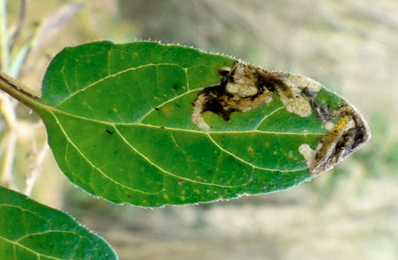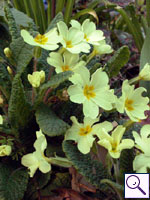|
||||||
|
PRIMULA. Cowslip, Oxlip and Primroses. [Primulaceae] |
|
|
Thirteen species of Primula are recorded in Britain. These include the native Bird's-eye Primrose (P. farinosa), Cowslip (P. veris), Oxlip (P. elatior), Primrose (P. vulgaris) and Scottish Primrose (P. scotica) and the introduced Auricula (P. auricula). Cowslip (P. veris) is protected in Northern Ireland under Schedule 8 of the Wildlife (Northern Ireland) Order, 1985. Six British miners are recorded on Primula. The polyphagous agromyzid Liriomyza trifolii has been recorded in quarantine in Britain (Pitkin & Plant in British leafminers). See also Liriomyza species in Glasshouses and/or Quarantine Interceptions. A key to the European miners recorded on Primula is provided in Bladmineerders van Europa. |
|
Key for the identification of the known mines of British |
1a > Leaf and stem miner: Eggs are scattered individually over the leaf upper surface; they are only loosely attached to the plant. The egg shell has a honeycomb structure. The larva begins with first mining one of the top leaves completely out. Next the larva moves down to another leaf, by way of a tunnel made in the stem. In this way several leaves are mined out, completely and full depth. In the attacked part of the plant the stem has become translucent; the damage causes the plant tip to wilt. In the first mines almost no frass is to be found, further down it is deposited in coarse grains. Pupation generally outside the mine (Miles, 1953). |
|
Delia echinata (Seguy, 1923) [Diptera: Anthomyiidae]. |
1b > Leaf-miner: A distinctive mine primarily above mid-rib, with irregular short lateral offshoots into leaf blade. Pupation external (Spencer, 1972: 51 (fig. 172), 55; Spencer, 1976: 270, 271 (fig. 486)). Branched, whitish, upper-surface corridor; main axis overlying the midrib; side branches overlying the main lateral veins. (In Campanula and Phyteuma the mine is much less branched, sometimes nothing more than a corridor on top of the midrib). Frass in rather long strings. Usually the mines begins as a long and narrow, shallow, tortuous lower-surface corridor that ends upon the midrib but otherwise is not associated with the leaf venation. Often this initial corridor is filled with callus, and then even less conspicuous. Pupation outside the mine. A linear mine on the upper surface, usually following the midrib and showing side branches along the veins. The frass is in strings. |
|
Liriomyza strigata (Meigen, 1830) [Diptera: Agromyzidae]. |
1c > Leaf-miner: Mine long and narrow, white, with frass in conspicuous, widely spaced black lumps. Pupation in the mine adjoining a vein, with anterior spiracles projecting through the epidermis (Spencer, 1976: 472). Untidy, generally for most part upper-surface, corridor. Frass in widely scattered, relatively large, grains. Pupation wthin the mine, generally in a lower-surface puparial chamber. Mine long and narrow, white, with frass in conspicuous, widely spaced black lumps. Pupation in the mine adjoining a vein, with anterior spiracles projecting through the epidermis. Anterior spiracles divided into two arms; posterior spiracles each on a large, widely-separated conical protuberance, with a total of up to 30 minute pores. |
|
Chromatomyia primulae (Robineau-Desvoidy, 1851) [Diptera: Agromyzidae]. |
1d > Leaf-miner: Rather long full depth corridor that winds freely through the leaf and may cross itself. In the end the corridor widens considerably. Frass mostly in a narrow central line, but may also be deposited along the sides or be missing. The larvae regular leave a mine to restart elsewhere. Pupation outside the mine. Neither larva or mine can be distinguished from that of related species. |
|
Apteropeda orbiculata (Marsham, 1802) [Coleoptera: Chrysomelidae]. |
1e > Leaf-miner: A short, irregular, linear upper surface mine on any part of the leaf. Also recorded from young pods (Bland, 1997a). Long corridor mine. As a rule the first part of the mine is lower-surface, the later part upper-surface. Often the loops are so dense that a secondary blotch is the result. Because upper- and lower-surface corridor segments often cross, the mine obtains a strange array of transparant patches. There is no association with the midrib. Frass in strings and thread fragments. Pupation outside the mine; exit slit in upper epidermis. Mine not associated with the veins or midrib of the leaf (It is this character which enables distinction from another Agromyzid pest species - Liriomyza huidobriensis). The larvae may leave one leaf (if not large enough) and enter another leaf, via the petiole). It exits the leaf to pupate through a semi-circular slit in the upper surface of the leaf. |
|
| Liriomyza bryoniae (Kaltenbach, 1858) [Diptera: Agromyzidae]. |
1f > Leaf-miner: Rather narrow corridor, untidy and sometimes branched, starting from the base of the leaf, in particular the midrib. Sides of the corridor irregularly eaten out, not really parallel. Frass mostly present, and then in a central line. The larva is capable of leaving the mine and start a new one elsewhere. These later mines are much broader, and the frass is scattered irregularly.. |
 Mine of Orthochaetes insignis on Prunella vulgaris Image: © Jean-Yves Baugnée (Bladmineerders van Europa) |
|
|
| Last updated 06-Jul-2019 Brian Pitkin | ||

